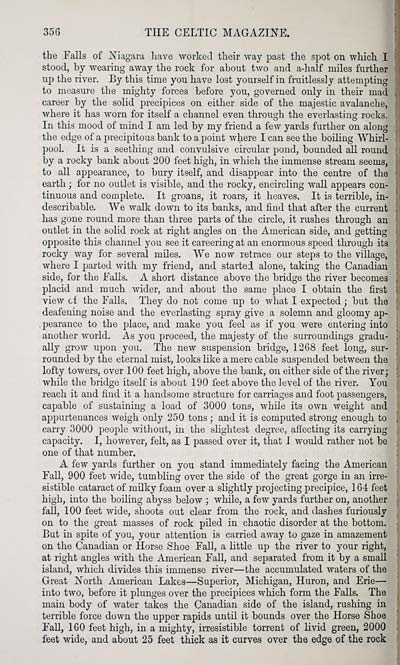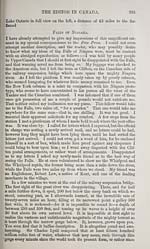Blair Collection > Celtic magazine > Volume 5
(366)
Download files
Complete book:
Individual page:
Thumbnail gallery: Grid view | List view

35G THE CELTIC MAGAZINE. j;
the Falls of J^iagara liave worked their way past the spot on which I i \
stood, by wearing away the rock for about two and a-half miles further i^
up the river. By this time you have lost yourself in fruitlessly attempting I i
to measure the mighty forces before you, governed only in their mad j
career by the solid precipices on either side of the majestic avalanche,
where it has worn for itself a channel even throiigh the everlasting rocks,
In this mood of mmd I am led by my friend a few yards further on along
the edge of a precipitous bank to a point where I can see the boiling Whirl-
pool. It is a seething and convulsive circular pond, bounded all round
by a rocky bank about 200 feet high, in which the immense stream seems,
to all appearance, to bury itself, and disappear into the centre of the
earth ; for no outlet is visible, and the rocky, encircling waU appears con-
tinuous and complete. It groans, it roars, it heaves. It is terrible, in-
describable. We walk down to its banks, and find that after the current
has gone round more than three parts of the circle, it rushes through an
outlet in the solid rock at right angles on the American side, and getting
opposite this channel you see it careering at an enormous speed through its
rocky way for several miles. We now retrace our steps to the village,
where I parted with my friend, and startei alone, taking the Canadian
side, for the FaUs. A short distance above the bridge the river becomes
placid and much wider, and about the same place I obtain the first
view cf the Falls. They do not come up to what I expected ; but the
deafening noise and the everlasting spray give a solemn and gloomy ap-
pearance to the place, and make you feel as if you were entering into
another world. As you proceed, the majesty of the surroundings gradu-
ally grow upon you. The new suspension bridge, 12G8 feet long, sur-
rounded by the eternal mist, looks like a mere cable suspended between the
lofty towers, over 100 feet high, above the bank, on either side of the river;
while the bridge itself is about 190 feet above the level of the river. You
reach it and find it a handsome structure for carnages and foot passengers,
capable of sustaining a load of 3000 tons, while its own weight and
appurtenances weigh only 250 tons ; and it is computed strong enough to
carry 3000 people without, in the slightest degree, affecting its carrying
capacity. I, however, felt, as I passed over it, that I would rather not bo
one of that number.
A few yards further on you stand immediately facing the American
Fall, 900 feet wide, tumbling over the side of the great gorge in an irre-
sistible cataract of milky foam over a slightly projecting precipice, 164 feet
high, into the boiling abyss below ; while, a few yards further on, another
fall, 100 feet wide, shoots out clear from the rock, and dashes furiously
on to the great masses of rock piled in chaotic disorder at the bottom.
But in spite of you, your attention is carried away to gaze in amazement
on the Canadian or Horse Shoe Fall, a little up the river to your right,
at right angles with the American Fall, and separated from it by a small
island, which divides this immense river — the accumulated waters of the
Great North American Lakes — Superior, Michigan, Huron, and Erie —
into two, before it plunges over the precipices which form the FaUs. The
main body of water takes the Canadian side of the island, rushing in
terrible force down the upper rapids until it bounds over the Horse Shoe
Fall, IGO feet high, in a mighty, irresistible torrent of livid green, 2000
feet wide, and about 25 feet thick as it curves over the edge of the rock
the Falls of J^iagara liave worked their way past the spot on which I i \
stood, by wearing away the rock for about two and a-half miles further i^
up the river. By this time you have lost yourself in fruitlessly attempting I i
to measure the mighty forces before you, governed only in their mad j
career by the solid precipices on either side of the majestic avalanche,
where it has worn for itself a channel even throiigh the everlasting rocks,
In this mood of mmd I am led by my friend a few yards further on along
the edge of a precipitous bank to a point where I can see the boiling Whirl-
pool. It is a seething and convulsive circular pond, bounded all round
by a rocky bank about 200 feet high, in which the immense stream seems,
to all appearance, to bury itself, and disappear into the centre of the
earth ; for no outlet is visible, and the rocky, encircling waU appears con-
tinuous and complete. It groans, it roars, it heaves. It is terrible, in-
describable. We walk down to its banks, and find that after the current
has gone round more than three parts of the circle, it rushes through an
outlet in the solid rock at right angles on the American side, and getting
opposite this channel you see it careering at an enormous speed through its
rocky way for several miles. We now retrace our steps to the village,
where I parted with my friend, and startei alone, taking the Canadian
side, for the FaUs. A short distance above the bridge the river becomes
placid and much wider, and about the same place I obtain the first
view cf the Falls. They do not come up to what I expected ; but the
deafening noise and the everlasting spray give a solemn and gloomy ap-
pearance to the place, and make you feel as if you were entering into
another world. As you proceed, the majesty of the surroundings gradu-
ally grow upon you. The new suspension bridge, 12G8 feet long, sur-
rounded by the eternal mist, looks like a mere cable suspended between the
lofty towers, over 100 feet high, above the bank, on either side of the river;
while the bridge itself is about 190 feet above the level of the river. You
reach it and find it a handsome structure for carnages and foot passengers,
capable of sustaining a load of 3000 tons, while its own weight and
appurtenances weigh only 250 tons ; and it is computed strong enough to
carry 3000 people without, in the slightest degree, affecting its carrying
capacity. I, however, felt, as I passed over it, that I would rather not bo
one of that number.
A few yards further on you stand immediately facing the American
Fall, 900 feet wide, tumbling over the side of the great gorge in an irre-
sistible cataract of milky foam over a slightly projecting precipice, 164 feet
high, into the boiling abyss below ; while, a few yards further on, another
fall, 100 feet wide, shoots out clear from the rock, and dashes furiously
on to the great masses of rock piled in chaotic disorder at the bottom.
But in spite of you, your attention is carried away to gaze in amazement
on the Canadian or Horse Shoe Fall, a little up the river to your right,
at right angles with the American Fall, and separated from it by a small
island, which divides this immense river — the accumulated waters of the
Great North American Lakes — Superior, Michigan, Huron, and Erie —
into two, before it plunges over the precipices which form the FaUs. The
main body of water takes the Canadian side of the island, rushing in
terrible force down the upper rapids until it bounds over the Horse Shoe
Fall, IGO feet high, in a mighty, irresistible torrent of livid green, 2000
feet wide, and about 25 feet thick as it curves over the edge of the rock
Set display mode to: Large image | Transcription
Images and transcriptions on this page, including medium image downloads, may be used under the Creative Commons Attribution 4.0 International Licence unless otherwise stated. ![]()
| Early Gaelic Book Collections > Blair Collection > Celtic magazine > Volume 5 > (366) |
|---|
| Permanent URL | https://digital.nls.uk/76453078 |
|---|
| Description | Volume V, 1880. |
|---|---|
| Shelfmark | Blair.6 |
| Attribution and copyright: |
|
| Description | A selection of books from a collection of more than 500 titles, mostly on religious and literary topics. Also includes some material dealing with other Celtic languages and societies. Collection created towards the end of the 19th century by Lady Evelyn Stewart Murray. |
|---|
| Description | Selected items from five 'Special and Named Printed Collections'. Includes books in Gaelic and other Celtic languages, works about the Gaels, their languages, literature, culture and history. |
|---|

